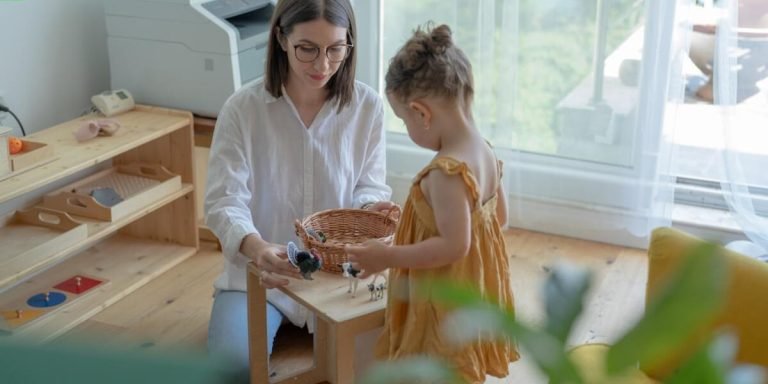Learning Differences: Unveiling the Spectrum in Child Education
Understanding “learning differences” in children is an essential part of modern education. It focuses on the unique ways each child grasps, interprets and assimilates information. But it’s not always easy to discern these individual learning styles or needs – especially when educating a class full of young minds with their varying strengths and challenges.
This intricacy becomes even more pronounced when we venture into special education, where every child has distinct requirements necessitating specialized resources and support. Whether you’re a seasoned educator, beginner teacher or concerned parent trying to navigate this multifaceted realm, having clear insights into the spectrum of learning differences can be pivotal in shaping effective strategies for each child’s academic journey.
Did you know?
Did you know that according to the National Center for Learning Disabilities, one in five children in the United States have learning and attention issues such as dyslexia and ADHD? However, 48% of parents believe incorrectly that kids can outgrow these brain-based learning differences.
Understanding Learning Differences in Special Education
Learning differences are an integral aspect of the diverse education framework, specifically in special education. In 2023, we find that technology is doing wonders by bridging these learning gaps and personalizing the educational experience for students with unique learning styles. Additionally, understanding these differences has become increasingly vital as it enables educators to curate individualized strategies leveraging various technological tools.
Technology integration plays a crucial role in accommodating children’s varying intellectual abilities within the landscape of special education. With advancements like AI-assisted systems or virtual reality simulations, teachers can address each student’s distinct needs effectively. This not only enhances comprehension but also fosters engagement and motivation among students having learning discrepancies.
Special Education Resources offer countless online platforms equipped with assistive technologies to support outstanding instruction while maximizing accessibility according to every child’s specific need. Enhanced voice recognition software application aids communication skills’ development; e-books provide customizable font size options where visual impairment could hinder progress – proving how acknowledging ‘learning differences’ led towards more inclusive classrooms globally.
Identifying Key Characteristics of Diverse Learning Needs
Recognizing and understanding the unique traits of diverse learning needs play a pivotal role in special education. As we navigate through 2023, it’s evident that “learning differences” are not just buzzwords but integral components of inclusive childhood education.
Technological advancements have proven instrumental in delivering individualized teaching techniques suited for these extraordinary scholars. By leveraging technology integration into students’ everyday curriculum, teachers can identify and cater to their specific educational requirements more effectively than ever before.
One primary advantage is adaptive software applications used today such as online interactive whiteboards which provide visual support aiding comprehension among learners with dyslexia or autism spectrum disorder (ASD). These digital tools accommodate multiple types of media like images, videos along with texts promoting better engagement amongst learners cultivating an environment conducive for holistic development regardless of their inherent abilities.
Language processing apps aid educators immensely while dealing with language-based disabilities by converting spoken word-to-text; highlighting grammatical constructs thereby making lessons engaging meanwhile improving child literacy rates significantly over time.
On the other hand virtual reality (VR) has revolutionised how children interact within a learning setting allowing them to virtually experience concepts often hard to grasp otherwise – bringing abstract ideas alive.
Tailoring Educational Strategies for Individual Learners
In the diverse world of special education, understanding learning differences is a key element. Each child comes with unique needs and talents that must be recognized in order for them to thrive academically.
, focuses on how educators can hone their teaching methods to cater specifically towards different types of learners. This approach has garnered popularity due to its effectiveness in reaching students who may not respond well under traditional educational techniques.
Technology integration plays a crucial role in this regard. In 2023, we have access to various technological tools that make personalized learning more accessible than ever before. Online platforms offer custom-made lessons catering individually according to each student’s capacity, pace and interest level – thus paving way into exploring endless possibilities within learning differences.
Essential Resources for Educators and Parents in Special Ed
In the realm of special education, accommodating learning differences remains pivotal. With technology integration being a defining factor in modern teaching methodology, it is imperative to stay informed and updated about comprehensive resources available for educators and parents alike.
Educators striving to create an inclusive environment for all learners increasingly rely on digital tools. Online platforms tailor specialized lessons to various learning styles and cognitive abilities. They provide:
- Interactive games that foster motor skills in children with physical disabilities
- Speech recognition software that aids those with communication challenges
- Adaptive devices that promote independent navigation for visually impaired students
This array of possibilities enables effective learning despite diverse educational needs.
Parents can take advantage of numerous online networks to interact with other caregivers in similar situations. These platforms offer valuable advice for managing behavioral issues and fostering social-emotional skills. Additionally, virtual libraries with accessible research literature make parenting less intimidating and more empowering by tailoring approaches to each child’s unique learning differences. Technology-driven resources strengthen the partnership between teaching and parenting, turning Special Education into a well-equipped journey that celebrates collective victories loudly.
Comprehensive Guides to Adaptive Learning Tools
Adaptive learning tools have become increasingly pivotal in addressing the diverse “learning differences” and bolstering special education. As we move through 2023, their integration into childhood education continues to gain momentum.
These innovative technologies function by customizing educational content according to each learner’s ability. It creates an individualized pathway that meets a child where they’re at academically, stimulating growth at their own pace.
One such tool is DreamBox Learning—an award-winning K-8 online math program employed extensively worldwide—the software adjusts its instructional approach based on students’ performance in real time. Its interactive games make mathematics engaging while honing problem-solving skills with intrinsic motivation.
Similarly, Read&Write—a literacy support software—improves reading comprehension for those who struggle due to dyslexia or other language-based learning disabilities. The digital platform reads text aloud from webpages or documents and offers predictive suggestions as learners type words improving vocabulary acquisition over time.
Another noteworthy resource includes BrainPOP’s Special Education suite providing numerous subjects ranging from Science, Social Studies to Math via animated videos thus making complex topics easier for young minds grasp.
Kurzweil 3000 – firefly incorporates unique features like voice notes allowing teachers add verbal instructions within assignments further enriching student interactions vis-a-vis eBooks; also textbooks come inclusive of dictionaries helping kids understand puzzle pieces viz., tough vocabularies used often in them.
Collaborative Networks for Sharing Best Practices
Amidst the diverse learning backgrounds of students today, harnessing collaborative networks for sharing best practices is vital. These virtual engagement platforms are proving especially crucial in helping educators and parents navigate the unique challenges linked with children experiencing various “learning differences”.
In 2023, forums like Collaborative Networks have become a highly trusted avenue to exchange effective strategies on integrating technology into special education scenarios.
What makes these platforms valuable? First off, they offer several accessible resources related to ‘Technology Integration in Education’. Educators can communicate real-time with peers worldwide who face similar experiences – all at a click of their device.
They’ve got access to an ocean of tried-and-tested methods that may assist them in tailoring personalized educational plans addressing each learner’s individual needs.
Parents aren’t left out either! Similar collaborative spaces grant them avenues to interact with other families dealing through comparable circumstances. It’s comforting knowing someone else understands your struggles while also providing practical solutions you might not have considered!
Moreover, these networks could be instrumental when it comes down to ‘Special Education Resources and Support.’ Online workshops highlighting ingenious techniques on how digital tools facilitate inclusive environments form part burgeoning online content within such settings.
Sharing success stories here provides holistic insights from multiple perspectives – a classroom teacher executing innovative tech applications or perhaps parents observing significant progress as their child gradually overcomes learning barriers via adaptive software usage becomes motivation pills for other members striving likewise!
Support Systems That Enhance Special Education Outcomes
The realm of special education has seen a considerable shift in recent years, hand-in-hand with advancements in technology. The integration of software and apps into the learning environment provides unique opportunities for students with learning differences to succeed acadically. Now more than ever, there are increasingly sophisticated support systems available designed specifically to enhance outcomes among these learners.
These digital tools not only offer personalization but also promote engagement and inclusion within educational settings. They allow teachers to provide differentiated instruction tailored precisely according to each student’s individual needs and capabilities. Such customization encourages self-paced learning – this is especially beneficial for children strugging due the pace or complexity typically found conventional classrooms.
Furthermore, online resources have expanded horizons significantly when it comes to parent involvement too – an crucial component no less pivotal towards achieving positive results in special education endeavours! Various platforms offering real-time tracking empower parents by ensuring they’re always just click away from their child’s progress reports; thereby enabling them contribute proactively during after-school hours despite physical distance constraints experienced earlier prior such technological leaps.
Role of Multidisciplinary Teams in Creating Inclusive Environments
Multidisciplinary teams play a significant role when it comes to fostering inclusive environments, especially for learners with differences. They offer comprehensive support that is tailored towards maximizing the potential of these individuals.
In 2023’s context and in line with technology integration in education, multidisciplinary teams are leveraging digital tools extensively. These include specialized software programs designed to accommodate learning differences. By harnessing this kind of advanced ed-tech resources, they can structure an adaptive educational framework that meets individual special needs efficiently.
One crucial aspect where these collectives shine brightly involves structuring Individualized Education Programs (IEPs). IEPs serve as personalized roadmaps guiding children who need specific interventions due to their unique learning characteristics through their academic journey successfully.
Impact of Family and Community Engagement on Student Success
When we discuss the impact of family and community engagement on student success, it becomes crucial to acknowledge how these elements can significantly enhance special education outcomes. Now more than ever, in our year 2023, breakthroughs in technology have offered us new opportunities for integration into the educational sphere.
The first point worth noting is families’ role in supporting children with learning differences. Families often serve as the primary facilitators of their child’s development through active involvement and collaboration with educators. They contribute valuable insights about a child’s strengths that ensure individualized learning plans are tailored effectively.
Technology now equips families with tools which were unavailable before; such as adaptive software programs designed specifically for kids managing learning differences or digital platforms that allow parents to participate virtually in meetings or discussions related towards shaping their kid’s educational direction.
Likewise, communities too play an instrumental role by fostering inclusive environments where students feel recognized and valued. Community-led initiatives encompassing workshops highlighting diversity acceptance or mentorship programs aimed at skill-building offer beneficial resources outside school boundaries enriching a pupil’s overall growth trajectory.
Conclusion
In the dynamic landscape of child education, understanding learning differences is not merely an obligation but a necessity. It’s all about embracing diversity in thought processes and encouraging every young mind to reach its full potential – because each one learns differently and that’s perfectly okay.
Unveiling this spectrum isn’t just beneficial for your children; it helps you as well – be it parents or educators alike. We encourage you to delve deeper into other resources available on our website, providing more insights into childhood education practices along with parent and educator support mechanisms. Let us continue unfolding the marvels of individuality together!







